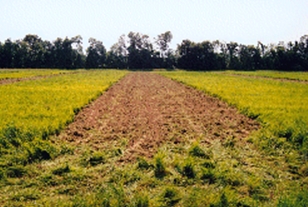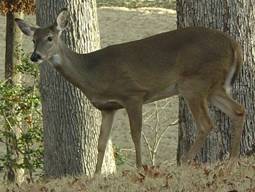Grenada Lake is committed to managing a diversity of habitats by utilizing a variety of natural resource management techniques and tools. Sound environmental stewardship efforts help preserve our natural resources for both game and non-game species alike. These include everything from waterfowl to bluebirds, whitetail deer and quail. Grenada Lake and the surrounding area provides critical habitat for wildlife.
Management Techniques
 Supplemental Food Plots
Supplemental Food Plots
Food plots are planted around the lake to help offset the destruction of habitat and provide food sources for wildlife. Strip disking is another wildlife enhancement technique used by Grenada Lake. Areas are disked in rows while leaving buffer zones which provide cover and nesting areas for wildlife.
 Control Burns
Control Burns
Prescribed burns is a natural tool used to control unwanted plants and manage wildlife habitats. Forests fires have occurred naturally in most ecosystems for thousands of years and some vegetative areas must have controlled burns in order for them to survive.
 Wildlife Management
Wildlife Management
Grenada Lake, along with other agencies, such as the U.S. Fish & Wildlife Service, Mississippi Department of Wildlife, Fisheries, and Parks, and Ducks Unlimited, maintain four wildlife management areas to provide improved nesting and feeding habitats for migrating waterfowl and native wildlife species.
Wildlife Management Areas
Three wildlife management areas, which are highlighted on the location map, are operated on Grenada Lake in partnership with private, state, and federal organizations.
Grenada Waterfowl Refuge: This 912 acre wildlife management area consists of a combination of land types including open agricultural land, beaver ponds, manmade impoundments, and bottomland hardwoods. Hunting is not permitted in the waterfowl refuge.
Benwood Waterfowl Management Area: This 1,400 acre wildlife management area is operated in partnership with the U.S. Fish and Wildlife Service. Water control structures are managed to drain water and allow for planting grain crops. Later the mature crops are flooded to provide feeding and resting areas for wintering waterfowl. This area is closed to hunting.
Haserway Wetland Demonstration Area: This area consists of 330 acres of wetlands, bottomland hardwoods, waterfowl food plots, and moist soil units. The primary objective of this area is the development, restoration, and enhancement of waterfowl habitat with special emphasis on public access and environmental interpretation. Some of the wildlife in this area includes fox, gray squirrels, white tail deer, woodpeckers, rabbits, beaver, turkey, opossums, quail, mourning doves, and numerous species of ducks. A 100 acre green tree reservoir and two shorebird wading ponds are also located in this area. Trails, bridges, and observation decks provide visitors with opportunities to view an assortment of wildlife. Displays provide information about wetland habitats and wildlife species. This area is closed to hunting.
Our wildlife biologist and natural resources rangers develop and plant approximately 120 acres in various areas around the lake to attract and enhance game species such as deer, turkey, duck, and quail. These food plots also benefit non-game species including many songbirds. The biologist and rangers also monitor and maintain approximately 90 bluebird boxes and 70 wood duck boxes. There are several bald eagle nests located on Grenada Lake, which are monitored for their protection, and the maintenance of records to protect these magnificent birds.
In partnership with the Mississippi Department of Wildlife, Fisheries, and Parks our biologist and natural resource rangers operate a five acre nursery pond for the production of game fish in an effort to enhance fishing on Grenada Lake. Each year volunteers construct approximately 700 – 800 fish shelters at our annual Fish Habitat Day allowing sportsmen the opportunity to give something back and maintain Grenada Lake as one of the premier crappie fishing lakes in the nation.


